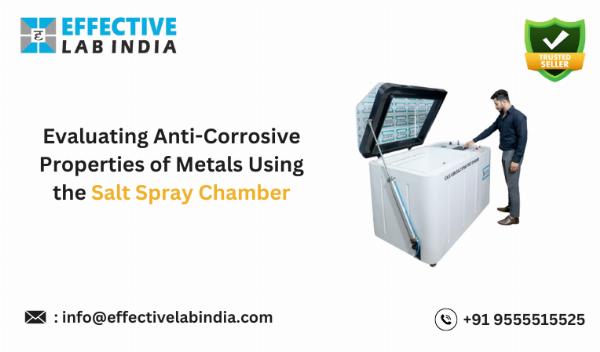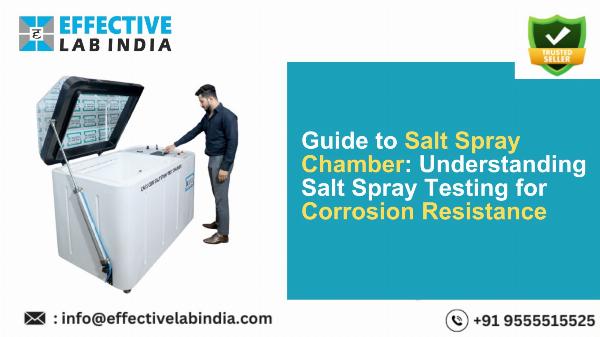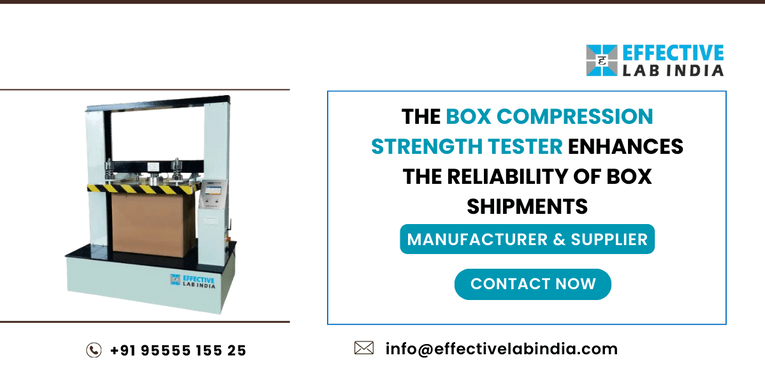 Affiliate Blog Copy – Sell Without Selling. Earn More Now!
Affiliate Blog Copy – Sell Without Selling. Earn More Now!
Understanding Salt Spray Test Chambers and Their Importance in Material Corrosion Testing
Written by Effective Lab India » Updated on: June 17th, 2025

A salt spray test chamber, also known as a salt fog test chamber, is an essential piece of equipment for assessing the corrosion resistance of materials and coatings. Manufactured by companies like Effective Lab India, these chambers simulate harsh environmental conditions, specifically salt-laden atmospheres, to evaluate how well a material can withstand corrosive forces.
How Does a Salt Spray Test Chamber Work?
A salt spray test chamber evaluates the corrosion resistance of materials and coatings by simulating a harsh saline environment. Here's how it works:
Preparation: Test specimens are cleaned and placed in the chamber.
Salt Solution: A 5% sodium chloride (NaCl) solution is prepared.
Spraying Mechanism: The system atomizes and sprays the salt solution uniformly over the specimens.
Controlled Environment: The chamber maintains a constant temperature, typically 35°C (95°F), to ensure consistent conditions.
Test Duration: The specimens are exposed to the salt spray for a predetermined period, ranging from a few hours to several thousand hours.
Evaluation: After the test, specimens are inspected for signs of corrosion, such as rust or blistering, to assess their durability and resistance.
This testing process helps determine the longevity and reliability of materials in corrosive environments.
Importance of Salt Spray Test Chambers in Material Corrosion Testing
Evaluation of Corrosion Resistance:
Material Durability: By subjecting materials to a controlled corrosive environment, manufacturers can determine the longevity and durability of their products under similar real-world conditions.
Coating Effectiveness: It helps in evaluating the performance of protective coatings, paints, and finishes designed to prevent rust and corrosion.
Quality Assurance:
Consistency: Regular testing ensures that products meet the necessary quality standards and specifications for corrosion resistance.
Product Improvement: Identifies weaknesses in materials or coatings, allowing manufacturers to make improvements and enhance product performance.
Compliance with Industry Standards:
Standards Adherence: Many industries, such as automotive, aerospace, and construction, require products to meet specific corrosion resistance standards (e.g., ASTM B117, ISO 9227). Salt spray testing ensures compliance with these standards.
Overview of Salt Spray Chamber
A salt spray chamber is an essential instrument used to evaluate the corrosion resistance of materials and coatings. This chamber replicates a saline environment to determine how well products can withstand corrosive conditions over time. Effective Lab India manufactures high-quality salt spray test chambers designed to meet rigorous industry standards, including ASTM B117 and JIS Z 2371.
Understanding ASTM B117 and JIS Z 2371 Standards
ASTM B117:
Origin: Established by ASTM International, this standard specifies the operating conditions for salt spray (fog) testing.
Application: Widely used in various industries to test the corrosion resistance of metallic materials and protective coatings.
JIS Z 2371:
Origin: Set by the Japanese Industrial Standards (JIS), this standard outlines the methods for salt spray testing of metallic coatings and materials.
Application: Commonly used in Japan and other regions to ensure the reliability and durability of products in corrosive environments.
Importance of Using ASTM B117-JIS Z 2371 Standards in Salt Spray Testing
Global Benchmarking:
Uniform Testing: Adherence to these standards ensures uniformity and consistency in testing procedures, making results comparable worldwide.
International Acceptance: Products tested according to ASTM B117 and JIS Z 2371 are recognized internationally, facilitating global trade and market acceptance.
Ensuring Material Durability:
Corrosion Resistance: Testing materials and coatings against these standards ensures they can withstand harsh environments, enhancing product durability.
Product Longevity: By simulating real-world corrosive conditions, these tests help in predicting the lifespan of materials, leading to longer-lasting products.
Quality Assurance and Control:
Reliability: Regular salt spray testing according to these standards helps maintain the high quality and reliability of products.
Consistent Production: Ensures that each batch of products meets the required corrosion resistance criteria, supporting consistent quality in manufacturing.
How to Test for Salt Spray
Salt spray testing is a standardized method used to evaluate the corrosion resistance of materials and coatings. The test involves exposing test specimens to a controlled saline environment in a salt spray (fog) test chamber. Here’s a step-by-step guide to conducting a salt spray test, based on ASTM B117 and JIS Z 2371 standards:
1: Preparation
Select Test Specimens:
Choose the materials or coated products that need to be tested for corrosion resistance.
Clean the specimens to remove any contaminants that might affect the test results.
Prepare the Salt Solution:
Mix sodium chloride (NaCl) with deionized or distilled water to create a 5% salt solution by weight.
Ensure the pH of the solution is between 6.5 and 7.2, adjusting if necessary with acetic acid or sodium hydroxide.
2: Setup the Salt Spray Test Chamber
Load the Specimens:
Place the test specimens in the chamber on non-corrosive racks or supports at an angle of 15 to 30 degrees from vertical.
Ensure that the specimens do not touch each other and are exposed to the mist uniformly.
Fill the Reservoir:
Fill the chamber’s reservoir with the prepared salt solution.
Adjust the Chamber Settings:
Set the chamber temperature to 35°C (95°F).
Configure the atomization system to generate a fine mist of the salt solution within the chamber.
3: Conduct the Test
Start the Test:
Initiate the test by turning on the chamber, which will begin spraying the salt mist.
Monitor the chamber to ensure consistent operation and mist distribution.
Duration:
The test duration can vary based on industry standards and the test's specific requirements. Common durations are 24, 48, 96, or even 1,000 hours, depending on the material and intended application.
Monitor the Test:
Regularly check the chamber to maintain the correct temperature and mist conditions.
Replenish the salt solution as needed to maintain consistent spraying.
4: Post-Test Procedures
End the Test:
At the end of the test period, turn off the chamber and carefully remove the test specimens.
Rinse the Specimens:
Rinse the specimens gently with deionized or distilled water to remove any salt deposits.
Dry the specimens using a non-reactive method, such as air drying.
Evaluate the Results:
Inspect the specimens for signs of corrosion, such as rust, blistering, or other forms of degradation.
Use visual examination and, if required, microscopic or other analytical methods to assess the extent of corrosion.
Compare the results against predefined criteria or standards to determine if the material meets the required corrosion resistance levels.
5: Documentation and Reporting
Record Observations:
Document the condition of each specimen before and after the test, noting any visible signs of corrosion.
Generate Reports:
Create detailed reports including test conditions, duration, observations, and compliance with the standards (ASTM B117, JIS Z 2371).
Include photographs and data charts to support the findings.
What is the 72-Hour Salt Spray Test?
The 72-hour salt spray test is a standardized corrosion test used to evaluate the durability and resistance of materials and coatings to a saline environment. Conducted in a salt spray test chamber, this test involves exposing test specimens to a continuous salt mist for 72 hours.
Key Points:
Objective:
To assess the corrosion resistance of metals and protective coatings.
Procedure:
Specimens are placed in the test chamber at an angle.
A 5% sodium chloride (NaCl) solution is atomized to create a saline mist.
The chamber is maintained at 35°C (95°F) for 72 hours.
Evaluation:
After 72 hours, specimens are inspected for signs of corrosion such as rust, blistering, or peeling.
Results are compared to standards (e.g., ASTM B117) to determine the effectiveness of the material or coating.
Importance:
The 72-hour salt spray test is crucial for industries like automotive, aerospace, and construction, ensuring that materials can withstand harsh environmental conditions, leading to improved product quality and longevity.
Note: IndiBlogHub features both user-submitted and editorial content. We do not verify third-party contributions. Read our Disclaimer and Privacy Policyfor details.
Men's Journal is a rugged and refined lifestyle adventure travel, food and drink Get in touch [email protected] to find out how we can help you reach everyday, affluent, and adventure seeking consumers on Men's Journal
Copyright © 2019-2025 IndiBlogHub.com. All rights reserved. Hosted on DigitalOcean for fast, reliable performance.













